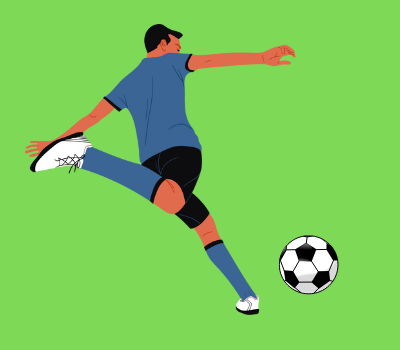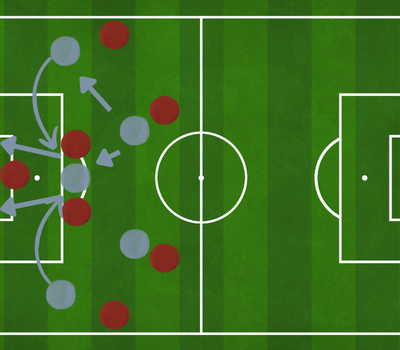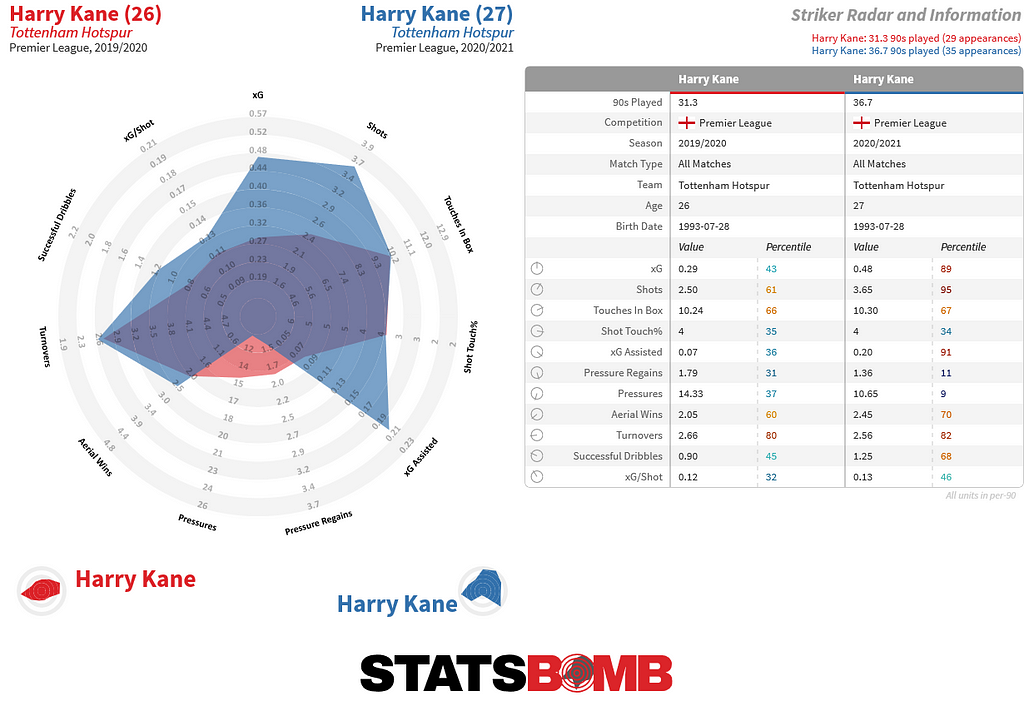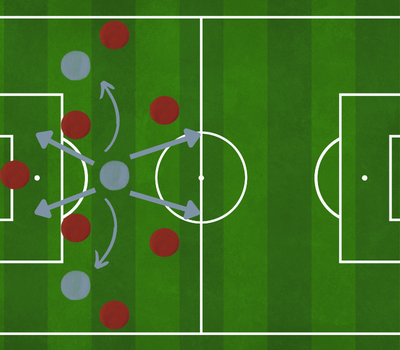
Sports Analytics 101–Attackers
Last Updated on June 26, 2022 by Editorial Team
Author(s): Nitin Chauhan
Originally published on Towards AI the World’s Leading AI and Technology News and Media Company. If you are building an AI-related product or service, we invite you to consider becoming an AI sponsor. At Towards AI, we help scale AI and technology startups. Let us help you unleash your technology to the masses.

This article is a theoretical and conceptual continuation of the article series of Sports Analytics 101. If you’ve read the previous articles in this series, please do make sure to check them out here.
Today we’ll walk through an understanding of attacking play and players that have played a considerable part in the game’s evolution. Yes, we’ll be discussing the role of 9s.
Traditional No. 9 ⚽️

Football is a fantastic game because it is both cyclical and ever-evolving. Trends and tactics come and go but never come back the same. There are always tweaks here and there to improve the game.
There was a time in the 90s and early 2000s when everyone played the same way. You set up in a 4–4–2 with a big target man, the ‘number 9’, and the ‘second striker’ or ‘center forward’ playing just behind him. Think Manchester United’s Ruud van Nistelrooy and Wayne Rooney.
It was the number 9’s responsibility to act as a target man for long balls and pass them on to the second striker running into space behind you or occupy the center backs, so your wingers, midfielders, and the second striker have more freedom to launch attacks. Upon receiving the ball from out wide, you entered the box and received a cross. Upon receiving the cross, you scored.
Key characteristics for various profiles of Attackers
- Shadow Striker — His primary objective is to occupy space between the opposing defense and midfield by roaming from his position and creating opportunities for teammates. He is technically proficient with good passing range and confidence while in possession. Besides that, the shadow striker can also finish and shoot from long distances. Examples of some players in this role: Antoine Griezmann (Atlético Madrid), Sadio Mané (Liverpool FC), Nabil Fekir (Olympique Lyon) and Andrej Kramaric (TSG 1899 Hoffenheim)
- Target Man — The target man is a physically strong player, capable of holding on to the ball under pressure and passing the ball to teammates in better positions. The target man is exceptionally good at offensive headers. An excellent player to use in conjunction with classic wingers when playing long balls to avoid pressure or when applying a direct or even one-route passing style. Examples of some players in this role: Mario Gómez (VfB Stuttgart), Troy Deeney (Watford FC), Luuk de Jong (PSV Eindhoven)
- Poacher — Striker with excellent timing, positioning, and finishing skills (specialist in close-range shooting) and the ability to exploit small pockets of space within the penalty box to often escape defenders’ attention. Most top finishers are pretty selfish and will strongly prefer attempting to score rather than passing the ball to a teammate who could be in (better) cutting positions. Examples of some players in this role: Mauro Icardi (Inter Milan), Mario Mandzukic (Juventus FC), Arkadiusz Milik (SSC Napoli), Mbwana Samatta (KRC Genk)
- Mobile Striker — A striker that benefits from the space behind the opposing defensive line. He is often reached through long balls from central defenders or defensively split balls from creative midfielders. It is common for mobile strikers to possess high technical and dynamic skills and the ability to distinguish themselves in one-on-one duels with a last defender or goalkeeper. It is often necessary to employ a mobile striker for fast transitions from defense to offense. Examples of some players in this role: Sergio Agüero (Manchester City), Luis Suarez (FC Barcelona), Kylian Mbappé (Paris Saint-Germain), Dries Mertens (SSC Napoli)
- Pressing Forward — A striker is used in teams adopting a high-pressing system. In possession, this player can hold up play and create chances for teammates or himself. He has excellent stamina and an incredible physique. He will try to disrupt the build-up of opposing central defenders, so they have to play long balls or pass the ball back to the goalkeeper. Examples of some players in this role: Diego Costa (Atlético Madrid), Joshua King (AFC Bournemouth), Joelinton (TSG 1899 Hoffenheim), Christian Kouamé (Genoa CFC)
Challenges
Teams once wanted players who had killer instincts, foxes in the box, and insane ball-striking ability. Suárez, Lewandowski, Ibrahimovic, and Vardy, a generation of forwards, remain unforgettable for their impressive goal-scoring records. Over the past few years, however, the concept of the omnipresent ‘false nine,’ a player whose movements outside the traditional penalty box have emerged as a phenomenon. Many reasons led to the tactic’s popularity: its defensive rigidity was ideal for managers of smaller clubs seeking to avoid relegation. Moreover, strikers are both hard to find and expensive, so reducing the amount a team has on their books by playing just one striker may reduce the amount on their books. In addition, it allowed teams to play their more creative midfielders centrally while still having two defensive midfielders to cover them behind them, which was a win for everyone!

It has become popular because Pep’s tiki-taka requires highly skilled players, whereas Klopp’s gegenpressing requires players to possess an irrepressible engine. Most teams do not have access to these players, so your best hope is to remain organized and challenge them to break down.
The major disadvantage of this style is that goals can be difficult to score if you do not have suitable personnel. Remember that part about football constantly evolving?
False 9 ⚽️

“Le football a change.” Translated, “Football has changed.” Does this sport offer any new ideas in a world where everything seems to have been absorbed by the past? The answer, probably, is a yes. Two England giants signed Darwin and Erling, two 9s renowned for their bullying methods towards opposing defenders, mainly because of their outstanding physical condition, in the middle of a few bidding wars. For two teams that play differently, most would not find Klopp’s methods similar to Pep’s ideologies, yet they have selected similar targets in both young 9s. Why is that?
Pep Guardiola and others in the football industry brought back vintage tactics with new additions. The concept was based on introducing a +1 player to roam the final third, giving an additional passing option, and making the man harder to mark. In the famous 6–2 Barcelona victory over Real Madrid, Los Blancos struggled to determine whether man-marking Lionel Messi or staying in the zone would be more effective. However, Madrid never found an answer as Lionel continued to move up and down: Lionel clearly understood what he would do. This margin gave him an edge both psychologically and tactically, which explains the score.
An excellent example of how False 9s provide a tactical advantage in the form of space and psychological benefit in the form of clarity was provided by Ferrino, despite not having the packed attributes of Lionel Messi. Others, like Thomas Müller, enjoyed continuous space being opened to them, earning them the nickname ‘Raumdeuter,’ which means ‘space investigator’ in German. All false nines share a common characteristic: Their outstanding space detection capability. False nines need great anticipation to be placed in the best position to break play and score.
Characteristics that are tied to False 9
- Creativity — In many cases, these ‘space investigators’ were rewarded with splendid sacrifices from their teammates, especially their wingers, as they continually threatened to run down the thing following a line-breaking pass from the false nine; Lionel Messi is the only player capable of handling this heavy role for such a long time. For others, such as Firmino, scoring and the rest of the work became increasingly difficult.
- Passing — Fortunately, building up is not as tricky: midfielders have become more adept at breaking lines and finding the right rhythm than ever before. As such, players such as Kevin De Bruyne, Bernardo Silva, and Thiago Alcantara demonstrate how effectively the park’s center has assisted the front line. The last pass is still available for midfielders to advance much more efficiently. It has become a new challenge for football players to receive these balls within a limited time and defeat the keeper in tight 1v1 situations.
- Drawing Defenders — Drawing defenders creates several options for the attacking team. A defensive position needs to be fixed or distracted, so ball strikers can focus on their specialties or liberate others: As a result, more and more midfielders are scoring more than ever, and they are advancing much higher than ever before. It is not always necessary to employ the so-called false nine — this is determined by the opponent’s weaknesses and the teammates they are playing with: Both are likely to continue living, but at this moment, it appears that the 9s will dominate the false nines.
Key Takeaways 📝
Arguably, 9s without technique no longer exist: Haaland’s involvement on the ball with Dortmund cannot be questioned, particularly. As a result, Klopp and Pep are looking to “new” solutions found in the forgotten past with new conditions, which may explain these two curious transfers. It should be noted that false nines were not invented to prevent 9s from existing or because Pep thought they were fun. They were merely solutions that require specific contexts; whether they will continue to exist is something only the future will tell.

I was amazed to this the shot chart of Romelu Lukaku for his spell at Inter Milan. Indeed it seemed to be an ideal fit for a team like Chelsea that has lacked high % xGs to fill the gap by bringing a player of such caliber. Chelsea bought Romelu Lukaku for a club-record fee of £101.70m; however, the player just managed to net 8 out of 26 games. Injury concerns, low confidence, and lack of adaptability to Tuchel’s game plan have been his significant drawbacks.
Attacking Midfielder can be generally replaced with a False 9 in the team’s absence of a genuine 9s. One good example is the use of Kai Havertz in Chelsea as False 9. His abilities on the ball, good passing range, and posing an aerial reach open the door for managers to replace out-of-form players like Romelu Lukaku.
If you like this article, follow me for more relevant content. For a new blog, or article alerts click subscribe. Also, feel free to connect with me on LinkedIn, and let’s be part of an engaging network.
Sports Analytics 101–Attackers was originally published in Towards AI on Medium, where people are continuing the conversation by highlighting and responding to this story.
Join thousands of data leaders on the AI newsletter. It’s free, we don’t spam, and we never share your email address. Keep up to date with the latest work in AI. From research to projects and ideas. If you are building an AI startup, an AI-related product, or a service, we invite you to consider becoming a sponsor.
Published via Towards AI
Take our 90+ lesson From Beginner to Advanced LLM Developer Certification: From choosing a project to deploying a working product this is the most comprehensive and practical LLM course out there!
Towards AI has published Building LLMs for Production—our 470+ page guide to mastering LLMs with practical projects and expert insights!

Discover Your Dream AI Career at Towards AI Jobs
Towards AI has built a jobs board tailored specifically to Machine Learning and Data Science Jobs and Skills. Our software searches for live AI jobs each hour, labels and categorises them and makes them easily searchable. Explore over 40,000 live jobs today with Towards AI Jobs!
Note: Content contains the views of the contributing authors and not Towards AI.















